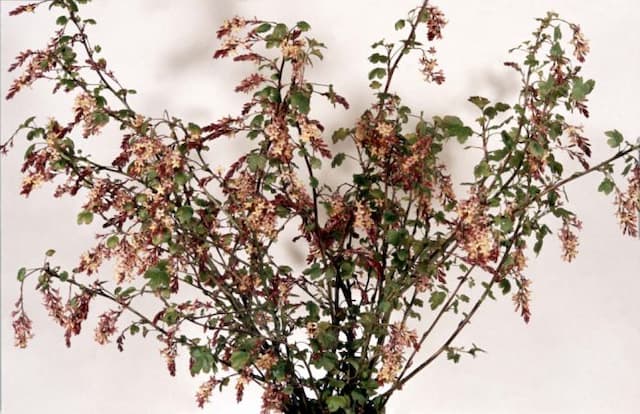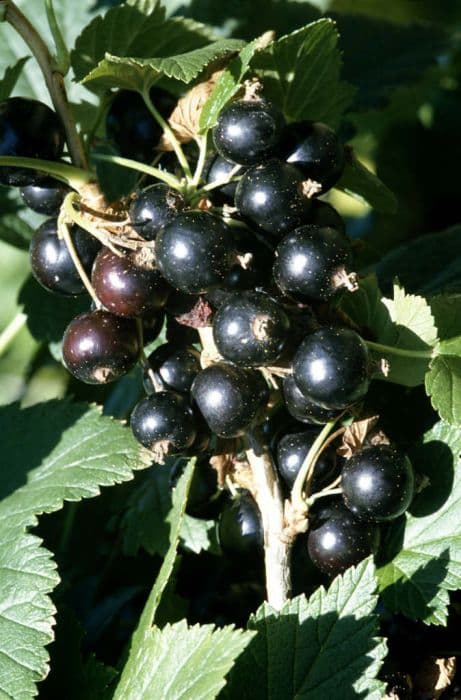Gooseberry Ribes uva-crispa 'Lord Derby' (C/d)

ABOUT
Ribes uva-crispa 'Lord Derby', more commonly known as Gooseberry 'Lord Derby', is a deciduous shrub that bears distinctive fruit and foliage. The plant has a bushy growth habit, with branches that spread outwards from the center, hosting a series of leaves and fruit. The leaves are notably lobed, typically three to five lobes per leaf, with a slightly toothed edge giving them a somewhat serrated appearance. They are a rich green color, providing a vibrant background for the fruit. The gooseberry fruits themselves are the standout feature of 'Lord Derby'. The berries are usually large, rounded, and slightly oval in shape, hanging from the branches in small clusters. When ripe, they exhibit a translucent green skin that often has a touch of red blush. The surface of the berries is veined, contributing to their intriguing look. Inside, the flesh is juicy and typically carries a balanced sweet-tart flavor profile. It's worth noting that the fruit is covered in a thin layer of downy hair which gives it a soft appearance. Although the plant's overall size in terms of height and spread is not to be mentioned, it is important to note that the branches are sturdy and well-suited to supporting the weight of the fruit. The gooseberry 'Lord Derby' is also known for its thorns, which are present along the branches, offering a natural form of defense.
About this plant
 Names
NamesFamily
Grossulariaceae.
Synonyms
Gooseberry, European Gooseberry, Northern Gooseberry.
Common names
Ribes grossularia 'Lord Derby', Grossularia reclinata 'Lord Derby', Grossularia uva-crispa 'Lord Derby'.
 Toxicity
ToxicityTo humans
Gooseberry plants, including the 'Lord Derby' variety, are not considered toxic to humans when consumed in normal food quantities. The ripe berries are edible and commonly used in cooking and baking. However, consuming unripe berries, leaves, or other parts of the plant in significant amounts could potentially cause stomach upset, but this is not common. There is no significant risk of poisoning from eating ripe gooseberries.
To pets
Gooseberry plants, such as the Ribes uva-crispa 'Lord Derby', are generally considered to be of low toxicity to pets, including cats and dogs. However, the plant's spines may cause physical injury if pets try to eat the leaves or stems. Ingesting the leaves or unripe berries in large quantities could potentially cause mild gastrointestinal upset, such as vomiting or diarrhea, but they are not known to cause serious poisoning or any severe symptoms in pets.
 Characteristics
CharacteristicsLife cycle
Perennials
Foliage type
Deciduous
Color of leaves
Green
Flower color
Varies
Height
3-5 feet (0.9-1.5 meters)
Spread
3-5 feet (0.9-1.5 meters)
Plant type
Shrub
Hardiness zones
5
Native area
Europe
Benefits
 General Benefits
General Benefits- Edible Fruit: Gooseberries from this plant can be eaten fresh or used in cooking, baking or preserves.
- Attractive Foliage: Adds aesthetic appeal to gardens with its bright green leaves.
- Wildlife Habitat: Provides food and shelter for birds and beneficial insects.
- Easy Cultivation: Adapts to a range of soil types and conditions, making it easy to grow for many gardeners.
- Can be Grown in Containers: Suitable for patios and small space gardening when planted in pots.
- Long Season of Interest: Flowers in the spring and fruits in the summer, providing garden interest for several months.
- Historical Variety: 'Lord Derby' is a heritage cultivar that can add a traditional feel to a garden.
- Pollinator Friendly: Flowers attract bees and other pollinators, supporting biodiversity.
 Medical Properties
Medical Properties- This plant is not used for medical purposes.
 Air-purifying Qualities
Air-purifying QualitiesThis plant is not specifically known for air purifying qualities.
 Other Uses
Other Uses- Gooseberries like Ribes uva-crispa 'Lord Derby' can be used in dye production; the fruit can produce a light greenish or purple dye for natural fabric coloring.
- The thorny branches can serve as a natural barrier when planted in hedges or at the perimeter of a property, deterring animals and uninvited guests.
- The dense foliage can provide a nesting territory for birds, offering a habitat and protective space for wildlife.
- Gooseberry bushes can be utilized in permaculture designs, integrated as part of a guild to support biodiversity in a garden.
- Leaves of the gooseberry can be used to create a subtle, aromatic tea that is enjoyed in some cultures for its unique flavor.
- When gooseberry plants are pruned, the cuttings can be used for propagating new plants through rooting or grafting methods.
- The fruit's natural pectin makes it an excellent ingredient for making homemade jellies and preserves without additional gelling agents.
- Young gooseberry shoots can be used as a source of food for some farm animals, particularly goats who may browse on the leaves.
- Gooseberry bush wood, being hard and durable, can be used for making small wooden tools or for intricate woodworking projects.
- During winter, the plant's resilience and persistence of foliage can provide a touch of greenery in otherwise barren gardens.
Interesting Facts
 Feng Shui
Feng ShuiThe Gooseberry is not used in Feng Shui practice.
 Zodiac Sign Compitability
Zodiac Sign CompitabilityThe Gooseberry is not used in astrology practice.
 Plant Symbolism
Plant Symbolism- Productivity: The Ribes uva-crispa 'Lord Derby', commonly known as the Gooseberry 'Lord Derby', is a fruit-bearing shrub, and its capacity to produce an abundance of fruit is often seen as a symbol of productivity and abundance.
- Patience: As a plant that takes time to mature and yield fruit, the Gooseberry 'Lord Derby' can symbolize the need for patience and the understanding that some rewards come only with time and effort.
- Protection: Gooseberry bushes typically have thorny branches, which can symbolize protection and defense, representing the idea of safeguarding what is valuable.
- Bittersweet experience: The gooseberry is known for its unique flavor profile that combines both tartness and sweetness, making it a symbol of the complexity of experiences, where both challenges and rewards can be intertwined.
- Domestic happiness: In some traditions, the gooseberry is associated with the simple pleasures of home and hearth, symbolizing domestic contentment and the enjoyment of familial bonds.
 Water
WaterGooseberries, including the 'Lord Derby' variety, prefer consistently moist soil, so it's best to water them deeply once a week, providing about 1-2 gallons of water per plant, depending on weather conditions and soil drainage. During hot, dry spells, additional watering may be necessary to maintain soil moisture, but be careful not to overwater as this can lead to root rot. A good method is to water the base of the plant slowly, allowing it to penetrate the soil and reach the roots without runoff. Mulching around the base can help conserve moisture.
 Light
LightGooseberries like 'Lord Derby' thrive best in full sun to partial shade. The ideal spot would provide at least 4 to 6 hours of direct sunlight each day, protecting the plant from the intense afternoon sun in regions with very hot summers. They adapt well to a range of light conditions but fruit production and quality are highest with adequate sunlight exposure.
 Temperature
TemperatureThe 'Lord Derby' gooseberry cultivar is hardy and can withstand cold temperatures down to about -40 degrees Fahrenheit, but the ideal growing temperatures range between 60 to 75 degrees Fahrenheit. During the active growing season, maintaining a temperate climate is key for optimal growth and fruiting. They can survive up to high temperatures around 85 to 90 degrees Fahrenheit, but consistently hotter conditions may stress the plants.
 Pruning
PruningRegular pruning of gooseberries like 'Lord Derby' is important to maintain plant health and maximize fruit production. Prune the bushes in late winter or early spring before new growth begins, removing dead or diseased wood, crossing branches, and opening up the center to allow sunlight and air circulation. It is also beneficial to prune for shaping and to encourage the growth of strong, fruit-bearing branches.
 Cleaning
CleaningAs needed
 Soil
SoilGooseberry 'Lord Derby' thrives in well-draining soil enriched with compost and organic matter. A soil pH of about 6.0 to 6.5 is optimal for this cultivar to promote healthy growth and fruit production. A mix consisting of two parts loam, one part peat, and one part sand or perlite provides a good balance of nutrients and drainage.
 Repotting
RepottingGooseberry 'Lord Derby' should be repotted every two to three years to refresh the soil and provide room for root growth. It is best to repot during the dormant season in late winter or early spring before new growth begins.
 Humidity & Misting
Humidity & MistingGooseberry 'Lord Derby' is adaptable to a range of humidity levels and does not require particularly high humidity. As an outdoor plant, it will thrive in average garden conditions, without needing any special humidity adjustments.
 Suitable locations
Suitable locationsIndoor
Ensure bright light, cool temp, water well.
Outdoor
Plant in sun/part shade, fertile soil, well-drained.
Hardiness zone
3-8 USDA
 Life cycle
Life cycleRibes uva-crispa 'Lord Derby', also known as Lord Derby gooseberry, begins its life as a seed which, when sown in well-draining soil and exposed to sunlight and moisture, germinates and sprouts into a seedling. The seedling then grows into a small shrub, developing woody stems and characteristic lobed leaves. In spring, the plant produces flowers which are usually pollinated by insects, leading to the formation of green, hairy fruits that mature to a larger size with a smoother skin and a tart yet sweet flavor. After fruiting, which typically occurs in early summer, the plant enters a period of dormancy in the colder months, shedding its leaves and becoming dormant to conserve energy. The following spring, the cycle resumes with new vegetative growth, flowering, and fruiting. Finally, after several years, the gooseberry plant will reach the end of its productive life span and, if not pruned or rejuvenated, will gradually decline and die.
 Propogation
PropogationPropogation time
Spring to Summer
Propogation: The most popular method of propagating the Ribes uva-crispa 'Lord Derby', commonly known as the Gooseberry 'Lord Derby', is through hardwood cuttings. This method is best carried out during the plant's dormant season, typically between late fall and late winter. To propagate using hardwood cuttings, select healthy, mature stems from the current or previous year's growth and cut them into lengths of 6 to 9 inches (about 15 to 23 centimeters). Each cutting should have at least three buds, with the lower cut made just below a bud and the top cut made above a bud to ensure proper orientation when planting. The cuttings are then inserted into moist soil with two-thirds of their length below the surface, allowing the top bud to be exposed. These cuttings will root over the winter months and can be transplanted to their final location in the following spring.








